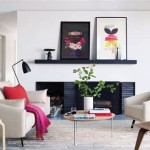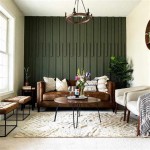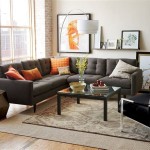Pictures For Decorating A Living Room: A Comprehensive Guide
Selecting the right pictures for decorating a living room is a crucial element in establishing the room's overall ambiance and aesthetic. Pictures, whether they are photographs, paintings, prints, or mixed media pieces, contribute significantly to the space's personality and can act as focal points, color accents, and conversation starters. Therefore, understanding the principles of art selection and placement is essential for creating a harmonious and visually appealing living room.
The process of choosing art for a living room requires careful consideration of several factors, including the room's existing décor, the desired mood, budget, and personal taste. There isn't a single right or wrong answer, but rather a spectrum of possibilities that depend on individual preferences and the specific characteristics of the living space. This article explores various aspects of selecting and arranging pictures for decorating a living room, providing guidance on achieving a balanced and visually engaging environment.
Consider the Room's Style and Color Palette
The existing style and color palette of the living room should significantly influence the selection of pictures. A room with a modern minimalist aesthetic, for example, would benefit from artwork that is similarly simple and uncluttered. Abstract art with clean lines or black and white photography can complement the minimalist style without overwhelming the space. Conversely, a living room with a more traditional or maximalist design might accommodate artwork with more elaborate frames, richer colors, and more intricate details.
The color scheme of the living room is another critical factor. Pictures should complement the existing colors in the room, either by harmonizing with them or by providing a contrasting accent. If the living room has a neutral color palette, artwork with bold colors can add a vibrant pop and create visual interest. Conversely, if the living room already features strong colors, artwork with a more subdued palette can help to balance the overall aesthetic and prevent the space from feeling overwhelming.
Matching the art to the existing style requires considering the furniture, textiles, and other decorative elements already present. A room with warm, earthy tones would benefit from artwork that incorporates similar colors, such as landscapes or portraits with muted tones. A room with cooler colors might benefit from artwork with blues, greens, and purples, creating a sense of cohesion and tranquility. The goal is to create a cohesive and visually appealing environment where the artwork feels like a natural extension of the existing décor.
Scale is also an important aspect of matching the artwork to the room’s style. A large, imposing piece of art can work well in a spacious living room with high ceilings, while a smaller, more delicate piece would be better suited for a smaller, more intimate space. Choosing the right size art ensures that it complements the room’s proportions and doesn't feel either undersized or overwhelming.
Determine the Focal Point and Arrangement
Every living room needs a focal point, and artwork can be instrumental in creating one. The focal point is the area that immediately draws the eye upon entering the room. This could be a fireplace, a large window, or a prominent wall. The artwork selected for this area should be visually impactful and serve as the central element of the room's décor. A large, statement piece of art is often ideal for a focal point, drawing attention and setting the tone for the rest of the room.
Once the focal point has been established, the arrangement of the artwork becomes crucial. There are several different ways to arrange pictures in a living room, each with its own advantages. One common method is the gallery wall, which involves grouping multiple pictures of different sizes and styles together on a single wall. Gallery walls can be highly effective in creating a visually engaging and eclectic look, but they require careful planning to ensure that the arrangement feels balanced and intentional.
Another option is to arrange pictures in a symmetrical or asymmetrical arrangement. A symmetrical arrangement involves placing identical or similar pictures in a balanced, mirrored fashion. This can create a sense of order and formality. An asymmetrical arrangement, on the other hand, involves placing pictures in a more free-form and less predictable manner. This can create a more relaxed and informal look.
When arranging pictures, it's important to consider the spacing between them. Too much space can make the arrangement feel disjointed, while too little space can make it feel cluttered. A general rule of thumb is to leave about 2-4 inches between pictures, but this can vary depending on the size and style of the artwork. It's also important to ensure that the pictures are hung at the correct height. The center of the artwork should be at eye level, which is typically around 57-60 inches from the floor.
Beyond the arrangement on the wall, consider how the art interacts with the furniture. A picture placed above a sofa should be proportional to the size of the sofa, neither dwarfing it nor being dwarfed by it. Consider the colors in the artwork in relation to the colors of the sofa and cushions. The goal is to create a visual harmony between the art and the furniture, enhancing the overall aesthetic of the living room.
Consider the Subject Matter and Personal Taste
While matching the artwork to the room's style and color palette is important, the subject matter of the pictures should also be carefully considered. The subject matter can significantly influence the mood and atmosphere of the living room. Landscape paintings, for example, can create a sense of tranquility and peace, while abstract art can add a touch of modern sophistication. Portraits can add a personal touch and create a sense of connection, while still life paintings can add a touch of classic elegance.
Ultimately, the pictures selected for decorating a living room should reflect personal taste. The living room is a space where individuals spend a significant amount of time, so it should be filled with artwork that they genuinely enjoy and that resonates with their personal style. While it's important to consider the overall aesthetic of the room, it's equally important to choose artwork that brings joy and inspiration.
When selecting artwork, it's helpful to consider the message or feeling that is desired to convey. For example, someone who values nature and the outdoors may choose landscape paintings or photographs of natural scenes. Someone who enjoys urban environments may choose artwork that depicts cityscapes or abstract representations of urban life. Someone who is interested in history or culture may choose artwork that reflects those interests.
Personal taste should also extend to the medium of the artwork. Some individuals may prefer traditional paintings on canvas, while others may prefer photography, prints, or mixed media pieces. There is no right or wrong answer, and the best choice depends on individual preferences and the overall aesthetic of the living room. The key is to choose artwork that feels authentic and meaningful.
Finally, consider the emotional impact of the artwork. Does it evoke feelings of joy, peace, excitement, or contemplation? The artwork should contribute to the overall atmosphere of the living room and create a space that is both visually appealing and emotionally resonant. By carefully considering the subject matter and personal taste, it is possible to select pictures that transform the living room into a personal sanctuary.
Choosing pictures to decorate a living room is a personalized experience. Take the time to explore different styles, subjects, and mediums. Visit art galleries, browse online collections, and consult with art advisors to find pieces that speak to individual tastes and complement the living space.
Proper lighting is crucial for showcasing artwork in a living room. Consider installing track lighting or individual spotlights to highlight specific pieces. Natural light is also beneficial, but be mindful of fading and damage to artwork caused by direct sunlight. Proper framing can enhance the appearance of the artwork and protect it from damage. Choose frames that complement the style of the art and the décor of the living room.
By carefully considering the room's style, the focal point, the arrangement, the subject matter, and personal taste, it is possible to select and arrange pictures that transform a living room into a visually appealing and emotionally resonant space. The process of decorating with pictures is an ongoing journey of discovery and refinement. Embrace experimentation and allow personal style to be reflected in the artwork. The result will be a living room that is truly unique and inspiring.

80 Gorgeous Living Room Decorating Ideas For Every Style

80 Gorgeous Living Room Decorating Ideas For Every Style
:strip_icc()/cdn.cliqueinc.com__cache__posts__212361__-2030968-1483470364.700x0c-8571e60cad7b42a981ab29ae10b5c153-497b002f87af4747b2ab38b560e7c0fd.jpg?strip=all)
Living Room Decorating 20 Ideas And Common Mistakes

Living Room Decorating Ideas And Inspiration My Bespoke

Spring Living Room Decorating Tips Citrineliving

4 Need To Know Tips For Decorating A Small Space

Small Living Room Ideas Decorating

Top 10 Ideas On How To Decorate A Small Living Room Decorilla Online Interior Design

Innovative Living Room Decorating Ideas For A Stylish Home

Living Room Decorating Tips Ideas And Essentials Spaces








